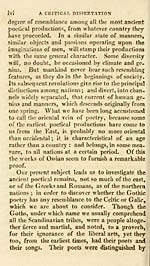Ossian Collection > Poems of Ossian > Volume 1
(75)
Download files
Complete book:
Individual page:
Thumbnail gallery: Grid view | List view

ox THE POEMS OP OSSIAN'. Ivil
the title of Scaldrrs, and their songs were termed
Vj/ses *. Saxo Grammaticns, a Danish historian
of considerable note who nourished in the thir-
* Olaus Wormhjs, in the appendix to his Treatise de
Literatura Runica, has given a particular account of the
Gothic poetry, commonly called Runic, from Runes, which
s^ignioes the Gothic letters. He informs us, that there
were no fewer than 136 different kinds of measure, or verse,
used in their Fyses ; and though we are accustomed to call
rhyme a Gothic invention, he says expressly, that among
all these measures, rhyme, or correspondence of final syl-
lables, was never employed. He analyses the structure of
one of these kinds of verse, that in which the poem ofLod-
brog, afterwards quoted, is written ; which exhibits a very
singular species of harmony, if it can be allowed that name,
depending neither upon rhyme nor upon metrical feet, or
quantity of syllables, but chiefly upon the number of the
syllables, and the disposition of the letters. In every stanza
was an equal n'amber of lines : in every line six syllables
In each distich, it was requisite that three words should, be-
gin with the same letter ; two of the corresponding words
placed in the first line of the distich, the third, in the second
line, in each line were also required two syllables, bu%
never the final ones, formed either of the same consonants,
or «ame vowels. As an example of this measure, Olaus
gives us these two Latin hnes, constructed exactly accord-
ing to the above rules of Runic verse :
Christns caput nostrum.
Coronet te bonis.
The initial letters of Chj-istu?, Capnt, and Coronet, make
the three corresponding letters of the distich. In the first
line, the 5rst syllables of Christus and of nostrum ; in the
second line, the on in coronet and in bonis make the requi-
site coiTespondence of syllables. Frequent inversions and
transpositions were permitted in this poetry ; which would
aaturalty follow from such laborious attention to the coiIe»-
cation of words.
The curious in this subject may consult likewise Dr.
Hicks's Thesaurus Linciudrum Septentrionallum ; particu-
iirly the 23d chapter of his Grammatica Anglo Sasonica el
the title of Scaldrrs, and their songs were termed
Vj/ses *. Saxo Grammaticns, a Danish historian
of considerable note who nourished in the thir-
* Olaus Wormhjs, in the appendix to his Treatise de
Literatura Runica, has given a particular account of the
Gothic poetry, commonly called Runic, from Runes, which
s^ignioes the Gothic letters. He informs us, that there
were no fewer than 136 different kinds of measure, or verse,
used in their Fyses ; and though we are accustomed to call
rhyme a Gothic invention, he says expressly, that among
all these measures, rhyme, or correspondence of final syl-
lables, was never employed. He analyses the structure of
one of these kinds of verse, that in which the poem ofLod-
brog, afterwards quoted, is written ; which exhibits a very
singular species of harmony, if it can be allowed that name,
depending neither upon rhyme nor upon metrical feet, or
quantity of syllables, but chiefly upon the number of the
syllables, and the disposition of the letters. In every stanza
was an equal n'amber of lines : in every line six syllables
In each distich, it was requisite that three words should, be-
gin with the same letter ; two of the corresponding words
placed in the first line of the distich, the third, in the second
line, in each line were also required two syllables, bu%
never the final ones, formed either of the same consonants,
or «ame vowels. As an example of this measure, Olaus
gives us these two Latin hnes, constructed exactly accord-
ing to the above rules of Runic verse :
Christns caput nostrum.
Coronet te bonis.
The initial letters of Chj-istu?, Capnt, and Coronet, make
the three corresponding letters of the distich. In the first
line, the 5rst syllables of Christus and of nostrum ; in the
second line, the on in coronet and in bonis make the requi-
site coiTespondence of syllables. Frequent inversions and
transpositions were permitted in this poetry ; which would
aaturalty follow from such laborious attention to the coiIe»-
cation of words.
The curious in this subject may consult likewise Dr.
Hicks's Thesaurus Linciudrum Septentrionallum ; particu-
iirly the 23d chapter of his Grammatica Anglo Sasonica el
Set display mode to: Large image | Transcription
Images and transcriptions on this page, including medium image downloads, may be used under the Creative Commons Attribution 4.0 International Licence unless otherwise stated. ![]()
| Early Gaelic Book Collections > Ossian Collection > Poems of Ossian > Volume 1 > (75) |
|---|
| Permanent URL | https://digital.nls.uk/77947141 |
|---|
| Shelfmark | Oss.79 |
|---|---|
| Additional NLS resources: | |
| Attribution and copyright: |
|
| Description | " ... to which are prefixed, 'Dissertations on the aera and poems of Ossian translated by James Macpherson'". |
|---|---|
| Shelfmark | Oss.79-80 |
| Additional NLS resources: | |
| Description | Selected books from the Ossian Collection of 327 volumes, originally assembled by J. Norman Methven of Perth. Different editions and translations of James MacPherson's epic poem 'Ossian', some with a map of the 'Kingdom of Connor'. Also secondary material relating to Ossianic poetry and the Ossian controversy. |
|---|
| Description | Selected items from five 'Special and Named Printed Collections'. Includes books in Gaelic and other Celtic languages, works about the Gaels, their languages, literature, culture and history. |
|---|

